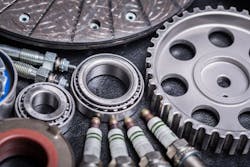Like many of you, I am grateful to see that we are turning the corner on dealing with the COVID-19 pandemic. I wonder how many people in our industry could have predicted some of the unintended consequences of the previous lockdowns that are now becoming evident. One of the biggest challenges our industry faces today is the unprecedented number of bottlenecks and delays in the supply chains that deliver parts to the doorsteps of the body shop. Couple that with the globalization of manufacturing and distribution and we find ourselves fighting hard against the headwinds of parts shortages and backlogs with no estimated time of arrival.
So, what are the good men and women of the collision repair industry supposed to do about this situation? Go back to the basics and, at the same time, innovate. I have already seen some remarkable responses to the parts backlog challenges and want to share some of my observations with you:
- There is no better time than the present to embrace blueprinting. Whatever you want to call it, they all end up with the same goal in mind, which is to account for all the damage and all the parts required to complete the repairs. This is done on day one of the repair process using a very methodical means of sorting and accounting for all parts and all repair versus replace decisions. The timing is good for implementing your system now, since I am sure your technicians and estimators are already tired of job delays, lack of flags due to stalled jobs, and upset customers asking why we did not catch all the damaged parts until the end of the repair.
- Do your parts sourcing and confirmation of ETAs during the blueprint process. If you submit a parts quote request to your vendors during blueprint, you will know what parts are on backorder now and can adjust your repair plan accordingly. This also helps eliminate surprises and the difficult conversations with customers that nobody wants to have during the repair.
- Consider alternative parts where appropriate. I do not pretend to think that my preferences about what kind of parts I want used on my own repair applies in every other repair scenario. I do believe that when parts are on backorder for an undetermined length of time, you owe it to the customer to give them all their options so they can decide about the type of parts that will be used. New, used, rebuilt, aftermarket and reconditioned parts can have a place in certain repairs.
- Repair more, replace less. Go find your nitrogen welder in the corner, dust it off and tune it up. Take an online refresher course on how to use it and start repairing those plastic and urethane parts that are on terminal backorder. If you have a panel that is a borderline replacement part, but the part is on backorder, you are going to repair that panel no matter what. Headlamps with damaged mounting tabs are probably going to experience a rise in repair versus replace frequency. Many OEMs endorse the idea of repairing headlamps that have certain types of damage. I’ve seen some that produce repair kits that include mounting brackets and others that include replacement lenses.
- Use vendors with whom you don’t normally trade. If they have the parts you need but won’t deliver, have them UPS or FedEx the parts to you. Maybe you’ll have to drive a couple hours each way to pick them up yourself. Think about using Uber or Lyft to drive the parts to you. If Uber can deliver you a hamburger, they might be willing to deliver a headlight.
- Think about using a 3D printer for making clips or fasteners or small brackets that can’t be sourced in a timely fashion. Think about doing partial repairs to make a vehicle safely drivable and get it back to the customer to use while waiting for non-critical parts.
- Know what globalization in manufacturing has done to vehicle platforms. Here is a true story that addresses this scenario: A shop I know that does a lot of BMW repairs recently took in a Mini with suspension and undercarriage damages. Unfortunately, the local Mini dealer closed its doors last year and the next closest Mini dealer (three hours away) didn’t have a wholesale parts department so the shop was in a bind to obtain parts. Somebody at the shop looked at the suspension damage and remarked that the damaged components looked identical to suspension parts on a BMW X1. Sure enough, the technician was correct so off he went to the BMW parts department to verify this. He cross referenced the parts needed to BMW part numbers and placed the parts order, which was fulfilled in a couple of days.
- We are going to be challenged with the supply chain issue for a while, but our customers aren’t aware of the extent of the problem. It is incumbent on us to have a dialogue with each customer at the beginning of the repair about these challenges. Communication up front and no surprises partway through the repair are keys to your success.
About the Author

Steve Morris
The late Steve Morris was the regional director for Classic Collision in California (formerly Pride Collision Centers). He was an Accredited Automotive Manager (AAM) and ASE-certified master technician. Morris died April 22, 2022, at the age of 63 of complications following surgery.
